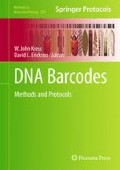Abstract
The assembly of sequence data obtained from DNA barcodes into phylogenies or NJ trees has proven highly useful in estimating relatedness among species as well as providing a framework in which hypotheses regarding the evolution of traits or species distributions may be investigated. In this chapter, we outline the process by which DNA sequence data is assembled into a phylogenetically informative matrix, and then provide details on the methods to reconstruct NJ or phylogenetic trees that employ DNA barcode data, using only barcode data or combining barcodes with other data.
Access this chapter
Tax calculation will be finalised at checkout
Purchases are for personal use only
References
Swofford DL, Olsen GJ, Waddell PJ, Hillis DM (1996) Phylogenetic inference. In: Hillis DM, Moritz C, Mable BK (eds) Molecular systematics. Sinauer Associates, Boston
Webb CO (2000) Exploring the phylogenetic structure of ecological communities: an example for rain forest trees. Am Nat 156:145–155
Harvey PH, Leigh Brown AJ, Maynard SJ, Nee S (2006) New uses for new phylogenies. Oxford University Press, Oxford
Smith MA, Rodriguez JJ, Whitfield JB et al (2008) Extreme diversity of tropical parasitoid wasps exposed by iterative integration of natural history. DNA barcoding, morphology, and collections. Proc Nat Acad Sci USA 105:12359–12364
Kress WJ, Erickson DL, Jones FA et al (2009) Plant DNA barcodes and a community phylogeny of a tropical forest dynamics plot in Panama. Proc Nat Acad Sci USA 106:18621–18626
Schreeg LA, Kress WJ, Erickson DL, Swenson NG (2010) Phylogenetic analysis of local-scale tree soil associations in a lowland moist tropical forest. PLoS One 5:e13685. doi:10.1371/journal.pone.0013685
Uriarte M, Swenson N, Chazdon R et al (2010) Trait similarity, shared ancestry, and the structure of neighborhood interactions in a subtropical forest: Implications for community assembly. Ecol Lett 13:1503–1514
Forest F, Grenyer R, Rouget M et al (2007) Preserving the evolutionary potential of floras in biodiversity hotspots. Nature 445:757–760
Hardy OJ, Jost L (2008) Interpreting and estimating measures of community phylogenetic structuring. J Ecol 96:849–852. doi:10.1111/j.1365-2745.2008.01423.x
Smith S, Beaulieu JM, Donoghue MJ (2009) Mega-phylogeny approach for comparative biology: an alternative to supertree and supermatrix approaches. BMC Evol Biol 9:37. doi:10.1186/1471-2148-9-37
Bininda-Emonds ORP (2005) transAlign: using amino acids to facilitate the multiple alignment of protein-coding DNA sequences. BMC Bioinformatics 6:156. doi:10.1186/1471-2105-6-156
Larkin MA, Blackshields G, Brown NP et al (2007) Clustal W and Clustal X version 2.0. Bioinformatics 23:2947–2948. doi:10.1093/bioinformatics/btm404
Katoh K, Misawa K, Kuma K-I, Miyata T (2002) MAFFT: a novel method for rapid multiple sequence alignment based on fast Fourier transform. Nucleic Acids Res 30:3059–3066. doi:10.1093/nar/gkf436
Edgar RC (2004) MUSCLE: multiple sequence alignment with high accuracy and high throughput. Nucleic Acids Res 32:1792–1797. doi:10.1093/nar/gkh340
Meier R, Shiyang K, Vaidya G, Ng PKL (2006) DNA barcoding and taxonomy in diptera: a tale of high intraspecific variability and low identification success. Syst Biol 55:715–728. doi:10.1080/10635150600969864
Maddison DR, Maddison WP (2000) MacClade 4: analysis of phylogeny and character evolution, version 4.0. Sinauer Associates, Sunderland, MA
Swofford DL (2002) PAUP*. Phylogenetic analysis using parsimony (* and other methods) version 4. Sinauer Associates, Sunderland, MA
Goloboff PA, Farris JS, Nixon KC (2008) TNT, a free program for phylogenetic analysis. Cladistics 24:774–786
Zwickl DJ (2006) Genetic algorithm approaches for the phylogenetic analysis of large biological sequence datasets under the maximum likelihood criterion. Ph.D. Dissertation, The University of Texas at Austin
Stamatakis A, Ott M, Ludwig T (2005) RAxML-OMP: an efficient program for phylogenetic inference on SMPs. In: Proceedings of 8th international conference on parallel computing technologies (PaCT2005). Lect Notes Comput Sci 3506288-302. Springer Verlag, Berlin
Evans J, Sheneman L, Foster JA (2006) Relaxed neighbor-joining: a fast distance-based phylogenetic tree construction method. J Mol Evol 62:785–792
Nixon KC (1999) The parsimony ratchet, a new method for rapid parsimony analysis. Cladistics 15:407–414
Driskell AC, Ané C, Burleigh JG et al (2004) Prospects for building the tree of life from large sequence databases. Science 306:1172–1174
Author information
Authors and Affiliations
Corresponding author
Editor information
Editors and Affiliations
Rights and permissions
Copyright information
© 2012 Springer Science+Business Media, LLC
About this protocol
Cite this protocol
Erickson, D.L., Driskell, A.C. (2012). Construction and Analysis of Phylogenetic Trees Using DNA Barcode Data. In: Kress, W., Erickson, D. (eds) DNA Barcodes. Methods in Molecular Biology, vol 858. Humana Press, Totowa, NJ. https://doi.org/10.1007/978-1-61779-591-6_19
Download citation
DOI: https://doi.org/10.1007/978-1-61779-591-6_19
Published:
Publisher Name: Humana Press, Totowa, NJ
Print ISBN: 978-1-61779-590-9
Online ISBN: 978-1-61779-591-6
eBook Packages: Springer Protocols

